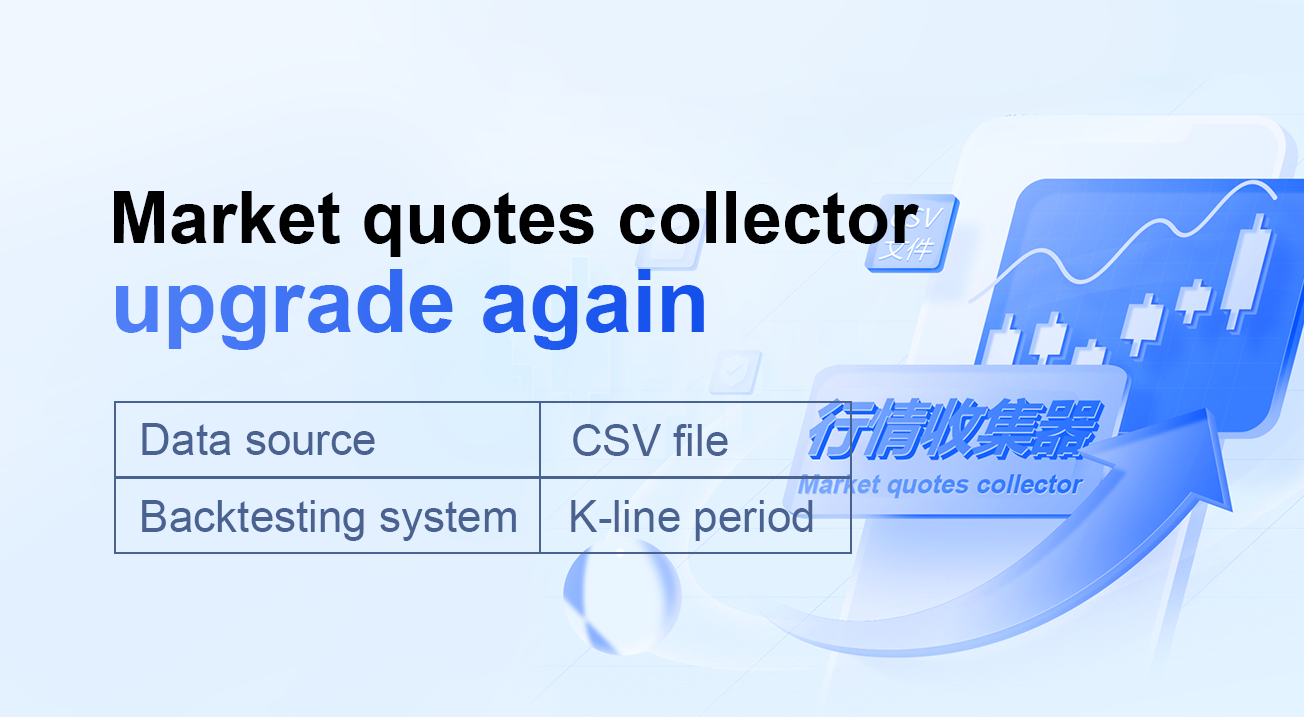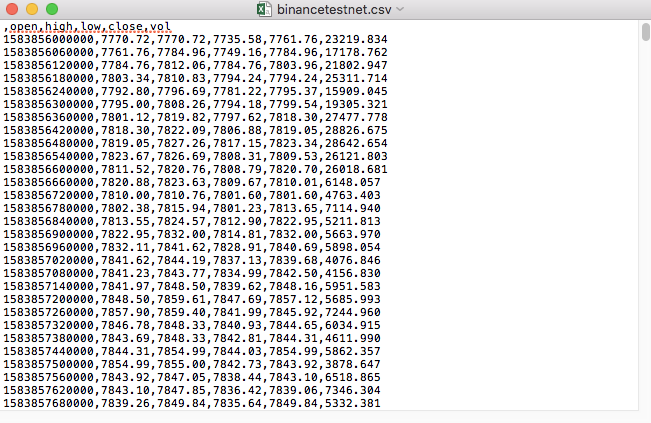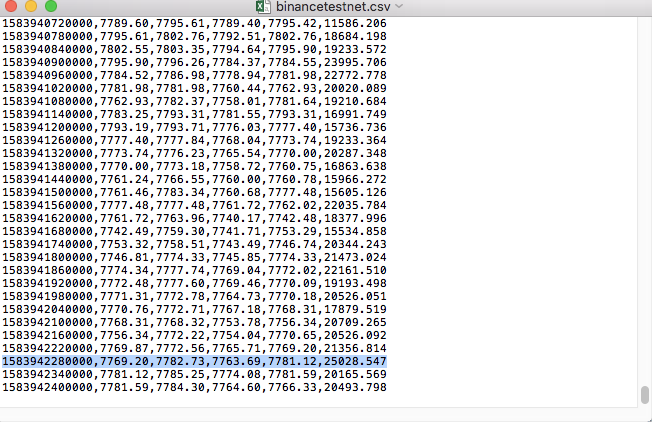Harga pasaran pengumpul menaik taraf lagi
Penulis:Kebaikan, Dicipta: 2020-05-26 14:25:15, Dikemas kini: 2024-12-10 20:35:48
Menyokong import fail format CSV untuk menyediakan sumber data tersuai
Baru-baru ini, seorang peniaga perlu menggunakan fail format CSV sendiri sebagai sumber data untuk sistem backtest platform FMZ. sistem backtest platform kami mempunyai banyak fungsi dan mudah dan cekap digunakan, sehingga selagi pengguna mempunyai data mereka sendiri, mereka boleh melakukan backtesting mengikut data ini, yang tidak lagi terhad kepada bursa dan varieti yang disokong oleh pusat data platform kami.
Idea reka bentuk
Idea reka bentuk sebenarnya sangat mudah. kita hanya perlu mengubahnya sedikit berdasarkan pengumpul pasaran sebelumnya. kita menambah parameterisOnlySupportCSVkepada pengumpul pasaran untuk mengawal sama ada hanya fail CSV digunakan sebagai sumber data untuk sistem backtest.filePathForCSVdigunakan untuk menetapkan laluan fail data CSV yang diletakkan di pelayan di mana robot pengumpul pasaran berjalan.isOnlySupportCSVParameter ditetapkan kepadaTrueuntuk memutuskan sumber data yang akan digunakan (dikumpulkan oleh anda sendiri atau data dalam fail CSV), perubahan ini adalah terutamanya dalamdo_GETFungsiProvider class.
Apakah fail CSV?
Nilai yang dipisahkan dengan koma, juga dikenali sebagai CSV, kadang-kadang dirujuk sebagai nilai yang dipisahkan dengan aksara, kerana aksara pemisah juga tidak boleh menjadi koma. Failnya menyimpan data jadual (nombor dan teks) dalam teks biasa. Teks biasa bermaksud bahawa fail adalah urutan aksara dan tidak mengandungi data yang mesti ditafsirkan seperti nombor binari. Fail CSV terdiri daripada mana-mana bilangan rekod, dipisahkan oleh beberapa watak baris baru; setiap rekod terdiri daripada medan, dan pemisah antara medan adalah watak atau rentetan lain, dan yang paling biasa adalah koma atau tab. Secara umum, semua rekod mempunyai urutan medan yang sama persis. Mereka biasanya fail teks biasa.WORDPADatauExceluntuk membuka.
Standard umum format fail CSV tidak wujud, tetapi terdapat peraturan tertentu, biasanya satu rekod setiap baris, dan baris pertama adalah tajuk. Data di setiap baris dipisahkan dengan koma.
Sebagai contoh, fail CSV yang kami gunakan untuk ujian dibuka dengan Notepad seperti ini:

Perhatikan bahawa baris pertama fail CSV adalah tajuk jadual.
,open,high,low,close,vol
Kami hanya perlu menganalisis dan menyusun data ini, dan kemudian membina ke dalam format yang diperlukan oleh sumber data tersuai sistem backtest. kod ini dalam artikel kami sebelumnya telah diproses, dan hanya perlu diubah suai sedikit.
Kod yang diubahsuai
import _thread
import pymongo
import json
import math
import csv
from http.server import HTTPServer, BaseHTTPRequestHandler
from urllib.parse import parse_qs, urlparse
def url2Dict(url):
query = urlparse(url).query
params = parse_qs(query)
result = {key: params[key][0] for key in params}
return result
class Provider(BaseHTTPRequestHandler):
def do_GET(self):
global isOnlySupportCSV, filePathForCSV
try:
self.send_response(200)
self.send_header("Content-type", "application/json")
self.end_headers()
dictParam = url2Dict(self.path)
Log("The custom data source service receives the request,self.path:", self.path, "query parameter:", dictParam)
# At present, the backtest system can only select the exchange name from the list. When adding a custom data source, set it to Binance, that is: Binance
exName = exchange.GetName()
# Note that period is the bottom K-line period
tabName = "%s_%s" % ("records", int(int(dictParam["period"]) / 1000))
priceRatio = math.pow(10, int(dictParam["round"]))
amountRatio = math.pow(10, int(dictParam["vround"]))
fromTS = int(dictParam["from"]) * int(1000)
toTS = int(dictParam["to"]) * int(1000)
# Request data
data = {
"schema" : ["time", "open", "high", "low", "close", "vol"],
"data" : []
}
if isOnlySupportCSV:
# Handle CSV reading, filePathForCSV path
listDataSequence = []
with open(filePathForCSV, "r") as f:
reader = csv.reader(f)
# Get table header
header = next(reader)
headerIsNoneCount = 0
if len(header) != len(data["schema"]):
Log("The CSV file format is wrong, the number of columns is different, please check!", "#FF0000")
return
for ele in header:
for i in range(len(data["schema"])):
if data["schema"][i] == ele or ele == "":
if ele == "":
headerIsNoneCount += 1
if headerIsNoneCount > 1:
Log("The CSV file format is incorrect, please check!", "#FF0000")
return
listDataSequence.append(i)
break
# Read content
while True:
record = next(reader, -1)
if record == -1:
break
index = 0
arr = [0, 0, 0, 0, 0, 0]
for ele in record:
arr[listDataSequence[index]] = int(ele) if listDataSequence[index] == 0 else (int(float(ele) * amountRatio) if listDataSequence[index] == 5 else int(float(ele) * priceRatio))
index += 1
data["data"].append(arr)
Log("data: ", data, "Respond to backtest system requests.")
self.wfile.write(json.dumps(data).encode())
return
# Connect to the database
Log("Connect to the database service to obtain data, the database: ", exName, "table: ", tabName)
myDBClient = pymongo.MongoClient("mongodb://localhost:27017")
ex_DB = myDBClient[exName]
exRecords = ex_DB[tabName]
# Construct query conditions: greater than a certain value {'age': {'$ gt': 20}} less than a certain value {'age': {'$lt': 20}}
dbQuery = {"$and":[{'Time': {'$gt': fromTS}}, {'Time': {'$lt': toTS}}]}
Log("Query conditions: ", dbQuery, "Number of inquiries: ", exRecords.find(dbQuery).count(), "Total number of databases: ", exRecords.find().count())
for x in exRecords.find(dbQuery).sort("Time"):
# Need to process data accuracy according to request parameters round and vround
bar = [x["Time"], int(x["Open"] * priceRatio), int(x["High"] * priceRatio), int(x["Low"] * priceRatio), int(x["Close"] * priceRatio), int(x["Volume"] * amountRatio)]
data["data"].append(bar)
Log("data: ", data, "Respond to backtest system requests.")
# Write data response
self.wfile.write(json.dumps(data).encode())
except BaseException as e:
Log("Provider do_GET error, e:", e)
def createServer(host):
try:
server = HTTPServer(host, Provider)
Log("Starting server, listen at: %s:%s" % host)
server.serve_forever()
except BaseException as e:
Log("createServer error, e:", e)
raise Exception("stop")
def main():
LogReset(1)
if (isOnlySupportCSV):
try:
# _thread.start_new_thread(createServer, (("localhost", 9090), )) # local test
_thread.start_new_thread(createServer, (("0.0.0.0", 9090), )) # Test on VPS server
Log("Start the custom data source service thread, and the data is provided by the CSV file. ", "#FF0000")
except BaseException as e:
Log("Failed to start the custom data source service!")
Log("Error message: ", e)
raise Exception("stop")
while True:
LogStatus(_D(), "Only start the custom data source service, do not collect data!")
Sleep(2000)
exName = exchange.GetName()
period = exchange.GetPeriod()
Log("collect", exName, "Exchange K-line data,", "K line cycle:", period, "Second")
# Connect to the database service, service address mongodb: //127.0.0.1: 27017 See the settings of mongodb installed on the server
Log("Connect to the mongodb service of the hosting device, mongodb://localhost:27017")
myDBClient = pymongo.MongoClient("mongodb://localhost:27017")
# Create a database
ex_DB = myDBClient[exName]
# Print the current database table
collist = ex_DB.list_collection_names()
Log("mongodb", exName, "collist:", collist)
# Check if the table is deleted
arrDropNames = json.loads(dropNames)
if isinstance(arrDropNames, list):
for i in range(len(arrDropNames)):
dropName = arrDropNames[i]
if isinstance(dropName, str):
if not dropName in collist:
continue
tab = ex_DB[dropName]
Log("dropName:", dropName, "delete:", dropName)
ret = tab.drop()
collist = ex_DB.list_collection_names()
if dropName in collist:
Log(dropName, "failed to delete")
else :
Log(dropName, "successfully deleted")
# Start a thread to provide a custom data source service
try:
# _thread.start_new_thread(createServer, (("localhost", 9090), )) # local test
_thread.start_new_thread(createServer, (("0.0.0.0", 9090), )) # Test on VPS server
Log("Open the custom data source service thread", "#FF0000")
except BaseException as e:
Log("Failed to start the custom data source service!")
Log("Error message:", e)
raise Exception("stop")
# Create the records table
ex_DB_Records = ex_DB["%s_%d" % ("records", period)]
Log("Start collecting", exName, "K-line data", "cycle:", period, "Open (create) the database table:", "%s_%d" % ("records", period), "#FF0000")
preBarTime = 0
index = 1
while True:
r = _C(exchange.GetRecords)
if len(r) < 2:
Sleep(1000)
continue
if preBarTime == 0:
# Write all BAR data for the first time
for i in range(len(r) - 1):
bar = r[i]
# Write root by root, you need to determine whether the data already exists in the current database table, based on timestamp detection, if there is the data, then skip, if not write
retQuery = ex_DB_Records.find({"Time": bar["Time"]})
if retQuery.count() > 0:
continue
# Write bar to the database table
ex_DB_Records.insert_one({"High": bar["High"], "Low": bar["Low"], "Open": bar["Open"], "Close": bar["Close"], "Time": bar["Time"], "Volume": bar["Volume"]})
index += 1
preBarTime = r[-1]["Time"]
elif preBarTime != r[-1]["Time"]:
bar = r[-2]
# Check before writing data, whether the data already exists, based on time stamp detection
retQuery = ex_DB_Records.find({"Time": bar["Time"]})
if retQuery.count() > 0:
continue
ex_DB_Records.insert_one({"High": bar["High"], "Low": bar["Low"], "Open": bar["Open"], "Close": bar["Close"], "Time": bar["Time"], "Volume": bar["Volume"]})
index += 1
preBarTime = r[-1]["Time"]
LogStatus(_D(), "preBarTime:", preBarTime, "_D(preBarTime):", _D(preBarTime/1000), "index:", index)
# Increase drawing display
ext.PlotRecords(r, "%s_%d" % ("records", period))
Sleep(10000)
Ujian berjalan
Pertama, kita mulakan robot pengumpul pasaran, kita tambahkan pertukaran kepada robot dan biarkan robot berjalan.
Konfigurasi parameter:


Kemudian kita mencipta strategi ujian:
function main() {
Log(exchange.GetRecords())
Log(exchange.GetRecords())
Log(exchange.GetRecords())
}
Strategi ini sangat mudah, hanya mendapatkan dan mencetak data K-line tiga kali.
Pada halaman backtest, tetapkan sumber data sistem backtest sebagai sumber data tersuai, dan isi alamat pelayan di mana robot pengumpul pasaran berjalan.

Klik untuk memulakan backtest, dan robot pengumpul pasaran menerima permintaan data:

Selepas strategi pelaksanaan sistem backtest selesai, carta garis K dihasilkan berdasarkan data garis K dalam sumber data.

Bandingkan data dalam fail:


- Pengenalan suite Lead-Lag dalam mata wang digital (3)
- Pengenalan kepada Arbitraj Lead-Lag dalam Cryptocurrency (2)
- Pendahuluan mengenai Lead-Lag dalam mata wang digital (2)
- Perbincangan mengenai Penerimaan Isyarat Luaran Platform FMZ: Penyelesaian Lengkap untuk Menerima Isyarat dengan Perkhidmatan Http Terbina dalam Strategi
- Penyelidikan penerimaan isyarat luaran platform FMZ: strategi penyelesaian lengkap untuk penerimaan isyarat perkhidmatan HTTP terbina dalam
- Pengenalan kepada Arbitraj Lead-Lag dalam Cryptocurrency (1)
- Perkenalkan led-lag suite dalam mata wang digital ((1)
- Perbincangan mengenai penerimaan isyarat luaran Platform FMZ: API Terpanjang VS Strategi Perkhidmatan HTTP Terbina dalam
- Penyelidikan penerimaan isyarat luaran platform FMZ: API yang diperluaskan vs strategi perkhidmatan HTTP terbina dalam
- Perbincangan mengenai Kaedah Ujian Strategi Berdasarkan Random Ticker Generator
- Mengkaji kaedah ujian strategi berdasarkan penjana pasaran rawak
- Beberapa Pemikiran mengenai Logik Dagangan Futures Mata Wang Kripto
- Alat analisis yang dipertingkatkan berdasarkan pembangunan tatabahasa Alpha101
- Mengajar anda untuk menaik taraf pengumpul pasaran backtest sumber data tersuai
- Kelemahan sistem penggambaran frekuensi tinggi berasaskan urus niaga dan penggambaran garis K
- Penjelasan mekanisme backtest tahap simulasi FMZ
- Cara terbaik untuk memasang dan menaik taraf FMZ docker pada Linux VPS
- Strategi R-Breaker Komoditi Hadapan
- Pertimbangkan Logik Dagangan Futures Mata Wang Digital
- Mengajar anda untuk melaksanakan pengumpul sebut harga pasaran
- Versi Python Komoditi Futures Moving Average Strategi
- Pemasangan semula pengumpul perkara - menyokong import fail dalam format CSV untuk menyediakan sumber data tersuai
- Komoditi Futures High Frequency Trading Strategy yang ditulis oleh C ++
- Larry Connors RSI2 Strategi Pembalikan Rendah
- Oker menolong anda menggunakan API penyebaran FMZ untuk menghubungkan JS
- Berdasarkan penggunaan indeks kekuatan relatif baru dalam strategi intraday
- Penyelidikan mengenai Strategi Hedging Multi-mata wang Binance Futures Bahagian 4
- Larry Connors Larry Connors RSI2 strategi pulangan purata
- Penyelidikan mengenai Strategi Hedging Multi-mata wang Binance Futures Bahagian 3
- Penyelidikan mengenai Strategi Hedging Multi-mata wang Binance Futures Bahagian 2
- Penyelidikan mengenai Strategi Hedging Multi-mata wang Binance Futures Bahagian 1